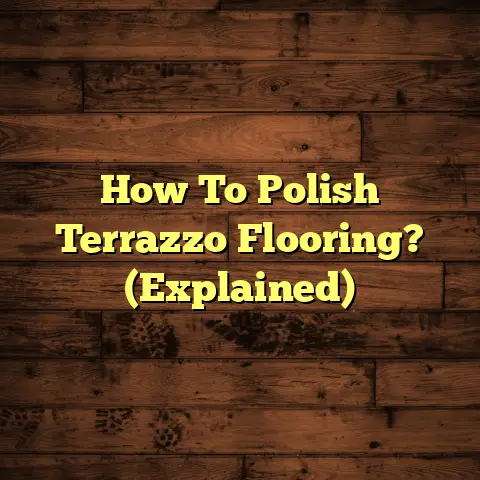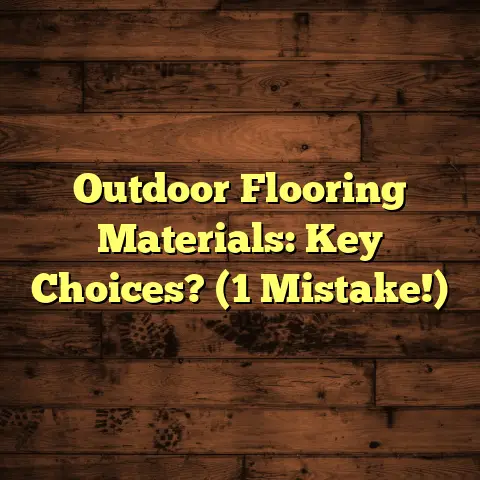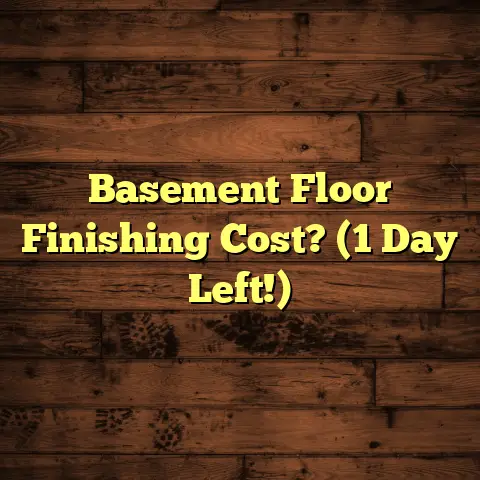Sweep or Vacuum Hardwood? (4 Pros Weigh In!)
Have you ever wished for a magical solution to keep your
hardwood floors spotless while preserving their natural
beauty?
I know I have!
As a flooring contractor for over
15 years, I’ve seen it all – from floors gleaming like
sun-kissed honey to those tragically scarred by
well-intentioned, but misguided, cleaning efforts.
Let’s dive into the age-old debate: is it better to sweep
or vacuum your hardwood floors?
I’ve consulted with
four pros – a seasoned cleaner, a vacuuming enthusiast,
a maintenance expert, and an environmental advocate – to
give you the lowdown.
Understanding Hardwood Floors
Hardwood flooring adds a touch of elegance and warmth
to any home.
From the classic appeal of oak to the
rich tones of cherry and the exotic grain of Brazilian
walnut, there’s a hardwood to suit every style.
But it’s not just about aesthetics.
Hardwood floors are
an investment, and proper maintenance is key to
preserving their beauty and extending their lifespan.
The finish on your hardwood floor – whether it’s a
polyurethane, oil-based, or wax finish – plays a
significant role in how you should clean it.
Different
finishes react differently to various cleaning methods
and products.
The Debate: Sweep or Vacuum?
So, what’s the verdict?
Is it better to sweep or vacuum
your hardwood floors?
The truth is, there’s no one-size-
fits-all answer.
Both methods have their pros and cons,
and the best choice for you will depend on your specific
needs and circumstances.
Sweeping is great for picking up larger debris like crumbs,
pet hair, and dust bunnies.
It’s also a relatively
inexpensive and low-tech option.
However, sweeping can
sometimes push dirt around rather than completely
removing it, and it may not be effective at capturing
fine dust particles.
Vacuuming, on the other hand, is excellent at removing
fine dust, allergens, and other microscopic particles
that sweeping might miss.
However, using the wrong type
of vacuum or vacuuming too aggressively can scratch or
damage your hardwood floors.
Let’s hear what our experts have to say!
Pro Insight #1: The Sweeping Advocate
Meet Maria, a professional cleaner with over 20 years
of experience.
Maria is a firm believer in the power
of sweeping.
“I always tell my clients, ‘Start with a good sweep!’”
Maria says.
“Sweeping is gentle on hardwood floors,
and it’s great for getting rid of those everyday messes
without causing any damage.”
Maria recommends using a soft-bristled broom specifically
designed for hardwood floors.
“Avoid brooms with stiff
or coarse bristles, as these can scratch the finish,”
she advises.
“Look for a broom with angled bristles
to reach into corners and along baseboards.”
Here are Maria’s top tips for sweeping hardwood floors:
- Sweep in the direction of the wood grain to avoid trapping dirt in the grooves.
- Use short, overlapping strokes to ensure you pick up all the debris.
- Pay special attention to high-traffic areas like entryways and hallways.
- Clean your broom regularly to remove any accumulated dirt and debris.
Maria also emphasizes the importance of using a dustpan
with a rubber edge that conforms to the floor.
This
will help you pick up even the smallest particles of
dirt and dust.
Pro Insight #2: The Vacuuming Enthusiast
Now, let’s hear from David, a vacuuming enthusiast who
runs a specialized cleaning service focused on allergen
removal.
David swears by vacuuming for maintaining
hardwood floors.
“Vacuuming is the best way to remove fine dust, pollen,
and other allergens that can accumulate on hardwood
floors,” David explains.
“A good vacuum cleaner with
the right attachments can leave your floors cleaner and
healthier than sweeping alone.”
David stresses the importance of using a vacuum cleaner
specifically designed for hardwood floors.
“Look for
a vacuum with a soft brush roll or a felt head,” he
advises.
“Avoid vacuums with beater bars, as these
can scratch or damage the finish.”
Here are David’s top tips for vacuuming hardwood floors:
- Use a vacuum with adjustable suction to avoid damaging delicate finishes.
- Vacuum in the direction of the wood grain.
- Use the hose attachment to reach tight spaces and corners.
- Empty the vacuum bag or canister regularly to maintain optimal suction.
- Consider using a vacuum with a HEPA filter to trap allergens and improve air quality.
David also recommends using a microfiber mop with a spritz of hardwood floor cleaner after vacuuming to remove any remaining dirt or residue.
Pro Insight #3: The Maintenance Expert
Next up is Sarah, a flooring maintenance expert who has seen firsthand the damage that improper cleaning methods can inflict on hardwood floors.
“I’ve seen floors ruined by harsh chemicals, abrasive
scrubbers, and even the wrong type of vacuum cleaner,”
Sarah laments.
“It’s so important to choose your
cleaning methods carefully and to maintain your floors
properly.”
Sarah believes that both sweeping and vacuuming can be
integrated into a comprehensive cleaning routine.
“I
recommend sweeping or vacuuming your hardwood floors
at least once a week, or more often if you have pets
or children,” she advises.
“In between, you can use a
microfiber mop to dust and remove any spills.”
Sarah also emphasizes the importance of protecting your
hardwood floors from scratches and dents.
“Use felt
pads under furniture legs, avoid wearing shoes with
high heels, and trim your pets’ nails regularly,” she
recommends.
Here are some real-life examples of how improper cleaning methods have affected hardwood floors over time:
- Scenario 1: A homeowner used a steam cleaner on their hardwood floors, causing the finish to bubble and peel.
- Scenario 2: A family used a vacuum with a beater bar on their hardwood floors, resulting in scratches and gouges.
- Scenario 3: A pet owner neglected to trim their dog’s nails, leading to scratches and dents on their hardwood floors.
Sarah’s key takeaway?
Prevention is key.
Proper
maintenance and careful cleaning habits can go a long
way in preserving the beauty and longevity of your
hardwood floors.
Pro Insight #4: The Environmental Advocate
Finally, let’s hear from Tom, an environmental advocate who is passionate about eco-friendly cleaning methods.
“Many conventional cleaning products contain harsh
chemicals that can be harmful to the environment and
your health,” Tom explains.
“Fortunately, there are
plenty of eco-friendly alternatives that are just as
effective at cleaning hardwood floors.”
Tom recommends using natural cleaning solutions like
vinegar and water or baking soda and water.
“These
solutions are gentle on hardwood floors and safe for
your family and pets,” he says.
Here’s a simple recipe for an eco-friendly hardwood floor cleaner:
- 1/4 cup white vinegar
- 1 gallon warm water
- A few drops of essential oil (optional, for fragrance)
Tom also emphasizes the importance of using sustainable
cleaning tools.
“Look for brooms and mops made from
recycled materials or natural fibers,” he advises.
“And consider using a vacuum cleaner with a reusable
filter.”
Here are some ways to make both sweeping and vacuuming more sustainable:
- Choose a broom made from bamboo or other sustainable materials.
- Use a vacuum cleaner with a reusable filter.
- Dispose of dust and debris responsibly.
- Avoid using disposable cleaning cloths or pads.
Tom’s message is clear: you can keep your hardwood floors clean and beautiful without harming the environment.
Comparative Analysis: Sweep vs. Vacuum
Let’s break down the pros and cons of each method in a side-by-side comparison:
Conclusion: The Best Approach?
So, what’s the best approach for cleaning your hardwood
floors?
As you’ve heard from our four pros, there’s no
definitive answer.
The best method for you will depend
on your specific needs, lifestyle, and floor conditions.
Here’s a quick recap of their insights:
- Maria (Sweeping Advocate): Sweeping is a gentle and effective way to remove larger debris without damaging your floors.
- David (Vacuuming Enthusiast): Vacuuming is the best way to remove fine dust, allergens, and other microscopic particles.
- Sarah (Maintenance Expert): Both sweeping and vacuuming can be integrated into a comprehensive cleaning routine, along with proper maintenance practices.
- Tom (Environmental Advocate): You can keep your hardwood floors clean and beautiful without harming the environment by using eco-friendly cleaning products and tools.
Ultimately, the choice is yours.
Experiment with both
sweeping and vacuuming to see what works best for you.
And remember, proper maintenance and careful cleaning
habits are essential for preserving the beauty and
longevity of your hardwood floors.
Final Thoughts
Maintaining hardwood floors doesn’t have to be a chore.
By making informed choices about cleaning methods and
embracing a consistent floor care routine, you can keep
your hardwood floors looking their best for years to come.
So, go forth and conquer those dust bunnies!
With the
expert insights you’ve gained today, you’re well-equipped
to take charge of your floor care routine and keep your
hardwood floors gleaming.
Happy cleaning!





